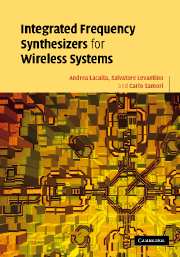4 - Electronic oscillators
Published online by Cambridge University Press: 09 August 2009
Summary
Introduction
Voltage controlled oscillators (VCOs) are used in virtually all wireless systems, where they are key elements of PLLs for frequency synthesis. Oscillators are not the simplest building block to design, simulate or model accurately. Oscillation starts to build up at the power-up, but as the signal amplitude increases, amplifier saturation and other non-linearities stabilize the oscillation amplitude. Large signals and non-linearities cannot be neglected in the prediction of phase noise, tuning range and power dissipation is not trivial at all. Several numerical methods have been developed to simulate VCO topologies rigorously and are nowadays embedded within the most common EDA (electronic design automation) products (see, for instance, [1]). However, quantitative formulae, bridging performance and circuit parameters, are essential to support first-order system partitioning and to provide insight for circuit optimizations.
A second issue is faced when designing silicon ICs. Oscillators for wireless applications have fully integrated LC resonators. External resonators, while offering higher selectivity, introduce other issues, such as the presence of multi-resonances and increasing application costs. However, the integration of all reactive components, such as inductors, capacitors and varactors, makes the VCO design even more challenging. On the other hand, alternative oscillator topologies, avoiding reactive elements, such as ring or relaxation stages, are unable to meet the required phase noise performance.
This chapter is devoted to a discussion of the operation of LC oscillators, introducing the concepts needed to address the phase noise evaluation and its optimization. Phase noise will, instead be covered in Chapters 5 and 7.
- Type
- Chapter
- Information
- Integrated Frequency Synthesizers for Wireless Systems , pp. 74 - 102Publisher: Cambridge University PressPrint publication year: 2007



